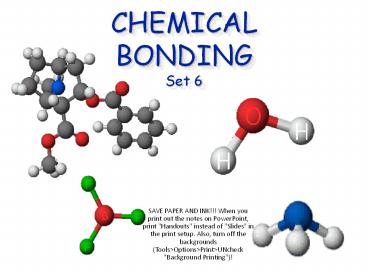CHEMICAL BONDING Set 6 - PowerPoint PPT Presentation
1 / 18
Title: CHEMICAL BONDING Set 6
1
CHEMICAL BONDINGSet 6
- Cocaine
SAVE PAPER AND INK!!! When you print out the
notes on PowerPoint, print "Handouts" instead of
"Slides" in the print setup. Also, turn off the
backgrounds (ToolsgtOptionsgtPrintgtUNcheck
"Background Printing")!
2
Credits
- Thank you to Mr. Neil Rapp who provided the bulk
of this powerpoint on his website
www.chemistrygeek.com - Other information comes from Zumdahl, Steven, and
Susan Zumdahl. Chemistry. Boston Houghton
Mifflin, 2003.
3
Bond Polarity
- HCl is POLAR because it has a positive end and a
negative end. (difference in electronegativity)
Cl has a greater share in bonding electrons than
does H.
Cl has slight negative charge (-d) and H has
slight positive charge ( d)
4
Molecular Polarity
- REMEMBER Polarity refers to a separation of
charges. - Entire molecules can be polar or nonpolar, too!
- Polar
- Nonpolar
5
Determining Molecular Polarity
- Draw the Lewis dot structure of the molecule.
- Find the polarity of each bond within the
molecule. - If ALL the bonds are nonpolar, the molecule is
nonpolar. - If one or more of the bonds is polar, determine
the symmetry of the molecule.
6
Molecular Symmetry
- Molecular symmetry is NOT the same as geometrical
symmetry! - Molecular symmetry occurs when all items (bonds
and/or lone pairs) on the central atom are
identical. - NOTE It matters what is attached, not how it is
attached (single, double, triple bonds count the
same!)
7
Symmetry
- If a molecule is symmetrical, the molecule is
NONPOLAR regardless of what types of bonds it
contains. - If a molecule is not symmetrical AND it has at
least one polar bond, the molecule is POLAR. - Lone pairs ? H atoms (not symmetrical)
- All atoms are F (symmetrical)
8
Intermolecular Forces
- Intermolecular forces forces of attraction
between molecules (like international between
countries) - Intramolecular forces forces of attraction
within a molecule, i.e. a bond
9
Types of Intermolecular Forces (IMFS)
- Dipole-dipole forces occurs between polar
molecules partial positive end of molecule A
attracts partial negative end of molecule B
10
Types of IMFs
- Hydrogen bonding a special subset of
dipole-dipole interactions occurs between H
atom of molecule A and F,O,N or S atom of
Molecule B
11
Types of IMFs
- Dipole-induced dipole forces attraction between
a polar molecule and nonpolar molecule the
polar molecule creates a temporary dipole in the
nonpolar molecule.
12
Types of IMFs
- London dispersion forces (or dipsersion forces or
van der Waals forces or induced dipole-induced
dipole forces) attractions between two nonpolar
molecules
13
(No Transcript)
14
Effects of IMFs
- Like Dissolves Like
- Polar dissolves Polar
- Nonpolar dissolves Nonpolar
- Other properties affected melting points,
boiling points
15
Properties of Three Molecular Compounds
Compound Molecular Formula Molar Mass (g) Boiling Point (C)
Water H2O 18.0 100
Methane CH4 16.0 -33.4
Ammonia NH3 17.0 -164
- Hydrogen bonds explain why water is a liquid at
room temperature, while compounds of comparable
mass are gases. - The difference between methane and water is easy
to explain because methane is nonpolar, the
only forces holding the molecules together are
relatively weak dispersion forces. - Ammonia and water is not as obvious molecules
of both can form hydrogen bonds, but the ammonia
is a gas which indicates its IMFs are not as
strong. This is because the EN difference between
N-H is a lot less than the EN difference between
O-H.
16
IMFs and Dissolving
- This is why oil and water will not mix! Oil is
nonpolar, and water is polar. - The two will repel each other, and so you can not
dissolve one in the other
17
HOMEWORK
- Explain what determines a substances state at a
given temperature. - Compare and contrast intermolecular forces and
describe intramolecular forces. - Evaluate which of the molecules listed below can
form hydrogen bonds. For which of the molecules
would dispersion forces be the only
intermolecular force? Give reasons for you
answers. - H2 b) H2S c) HCl d) HF
18
MORE HOMEWORK
- 4) In a methane molecule (CH4), there are four
single covalent bonds. In an octane molecule
(C8H18), there are 25 single covalent bonds. How
does the number of bonds affect the dispersion
forces in samples of methane and octane? Which
compound is a gas at room temperature? Which is a
liquid?































